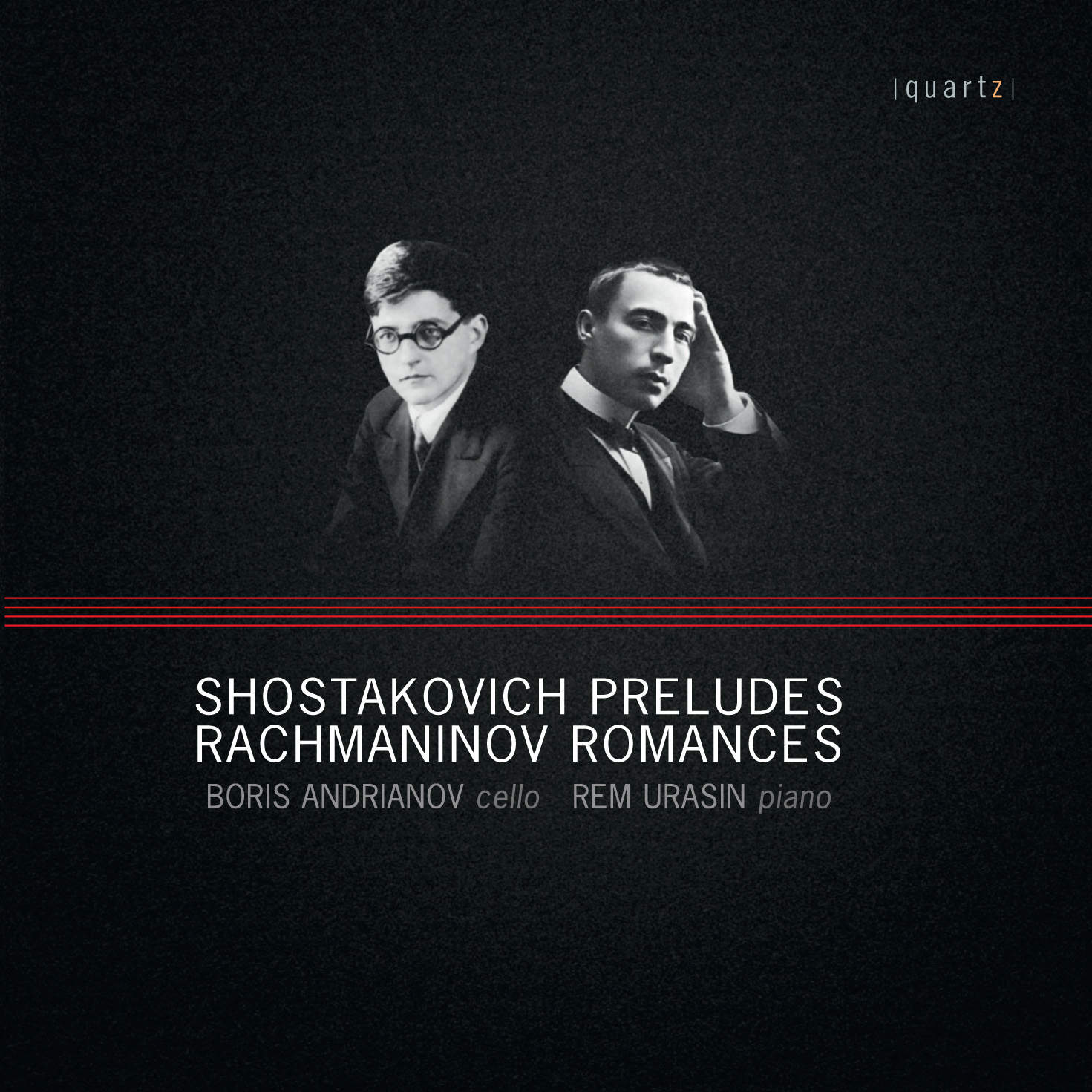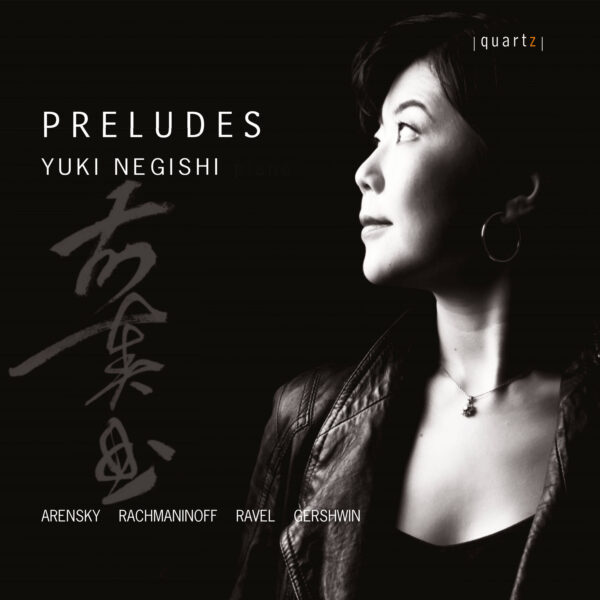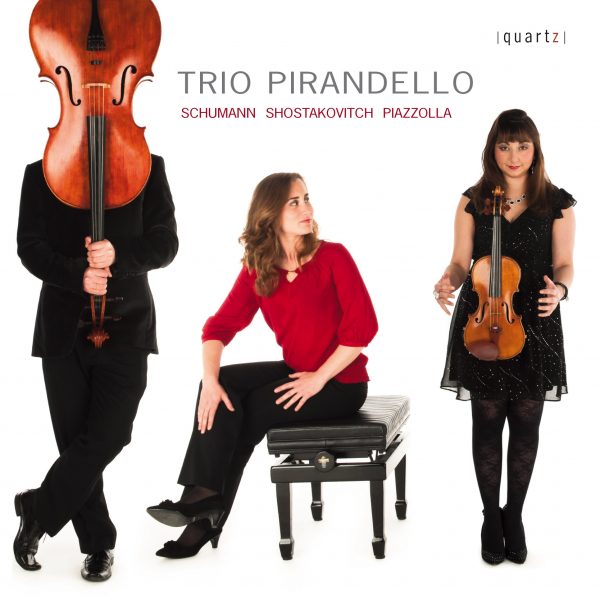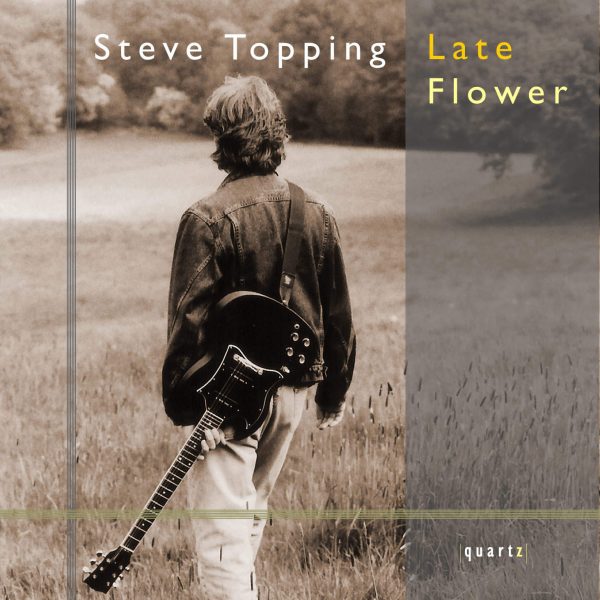Shostakovich Preludes and Rachmaninov Romances
Price range: £5.99 through £11.99
DMITRY SHOSTAKOVICH
15 Preludes from Opus 34
Transcribed by Rem Urasin
SERGEI RACHMANINOV
Songs transcribed for cello and piano
Transcribed by Rem Urasin
Boris Andrianov and Rem Urasin’s new disc, like their previous, is dedicated to the music of two great Russian composers, Rachmaninov and Shostakovich. In Russia the 20th century was a time of vast historical and cultural change. If Rachmaninov’s Romances are the poignant swansong of late Romanticism and the passing age, the young Shostakovich’s piano preludes, written a mere 20 years later, create a wholly new sort of expression: a hitherto undreamt-of grotesquerie, an irony turning to sarcasm, a sometimes ecstatic lyricism.
This programme presents a unique transcription of Rachmaninov’s Romances, letting us see them in an entirely new light. The cello takes the place of the voice, elevating the music into a world of imagery, finessing the words which usually bring these images to concrete life.
The highlight is the 15 Shostakovich Preludes, in Urasin’s transcription for cello and piano. In contrast to Tsyganov’s well-known transcriptions for violin and piano ‘ where the piano’s role is that of a modest escort to the soloist ‘ Urasin’s version is full-blown chamber music: both partners are engaged in a constant dialogue, sometimes heated.
About This Recording
Boris Andrianov and Rem Urasin’s new disc, like their previous, is dedicated to the music of two great Russian composers, Rachmaninov and Shostakovich. In Russia the 20th century was a time of vast historical and cultural change. If Rachmaninov’s Romances are the poignant swansong of late Romanticism and the passing age, the young Shostakovich’s piano preludes, written a mere 20 years later, create a wholly new sort of expression: a hitherto undreamt-of grotesquerie, an irony turning to sarcasm, a sometimes ecstatic lyricism.
This programme presents a unique transcription of Rachmaninov’s Romances, letting us see them in an entirely new light. The cello takes the place of the voice, elevating the music into a world of imagery, finessing the words which usually bring these images to concrete life.
The highlight is the 15 Shostakovich Preludes, in Urasin’s transcription for cello and piano. In contrast to Tsyganov’s well-known transcriptions for violin and piano – where the piano’s role is that of a modest escort to the soloist – Urasin’s version is full-blown chamber music: both partners are engaged in a constant dialogue, sometimes heated.
© Boris Andrianov & Rem Urasin, 2014
Amongst the most important voices to emerge during the 20th century was that of Dmitri Shostakovich, whose earliest piano works are somewhat astringent, but whose 24 Preludes, written between 1932 and 1933, are warmer and wittier, and bear the influence of Prokofiev (the Visions fugitives, especially). Shostakovich was, of course, aware of the precedents set by earlier composers in this field, Preludes by Bach, Chopin, Rachmaninov and Debussy among them, and he strove to reconcile aspects of those styles with his own musical language.
Shostakovich had admitted in 1927 that, ‘Generally speaking, I composed a lot unde the influence of external events’. While this continued to be true for much of the composer’s life, the piano preludes are remarkable for their relatively self-contained nature, one which lends itself to transcription. No.7 in A, is an enigmatic Andante, whereas the A Minor Prelude, No.2, is a witty waltz, skittish and concise. The specific mix of textures used in No.3, in G, a blend of lyricism, angular lines and dramatic gestures, is particularly reminiscent of Prokofiev, and No.5 in D (the so-called ‘Velocity etude’) is a ferociously quick flurry of notes, possibly satirising the more indulgent forms of extreme virtuosity. The next Prelude, in B Minor, is one of the most overtly humorous, with wonderfully jangling sonorities and disjunct ideas, whereas No.10, in C-sharp Minor, contrasts a Russian Romanticism reminiscent of Tchaikovsky and Rachmaninov with spiky, ironic interjections.
The B Major Prelude, No.11, is a gloriously busy piece culminating, to humorous effect, in unexpectedly soft cadences. The funereal, almost Lisztian Prelude No.14, in E-flat Minor, is juxtaposed with the D-flat Major Prelude’s manic waltz, followed by an unhinged march, in B-flat Minor, No.16. The next two preludes continue this wonderful idiom of recognisable genres which Shostakovich has detuned, set off kilter, distorted in some way, to create amusing and unsettling effects. We hear a Prelude in A-flat Major that is Romantic in spirit but for a few warped gestures that reveal Shostakovich to be its author, and a nervous F Minor Prelude, No.18.
The frenzied Prelude No.20, in C Minor, unleashes a brief but torrential downpour of gestures, whereas No.22 in G Minor is a melancholic study which makes fascinating use of the piano’s spatial qualities, exploiting its resonances with remarkable colouristic variety, qualities highlighted by the cello’s articulation of key lines in the original material. Yet irony returns in the final Prelude, No.24 in D Minor, with its mixture of creeping chromatic lines, angular figures, an undulating central passage ratcheting up the tension, and a throwaway ending.
As works which are not obviously written ‘under the influence of external events’, these Preludes offer the listener an exceptional insight into Shostakovich’s style and, indeed, his character. Although his output is inevitably dominated by the symphonies, these subtler works should not be overshadowed. Benjamin Britten put it this way in his 1966 tribute to Shostakovich – on the occasion of the latter’s 60th birthday:
‘… much as I admire the Symphonies and the opera, to me Shostakovich speaks most closely and most personally in his chamber music. There is a time in every artist’s life when he wishes to communicate intimate thoughts to a few friends – and I do not mean only his actual friends, but people unknown to him, who have souls sensitive to his (people from all over the world, whatever race or colour). And for this one doesn’t need the mass of full chorus or orchestra and the big halls and theatre, but small groups of performers and small halls, sometimes only private rooms.’
Sergei Rachmaninov was rather more perplexed by the musical innovations of the 20th century. Writing in 1939, he admitted:
‘I feel like a ghost wandering in a world grown alien… I cannot cast out the old way of writing, and I cannot acquire the new. I have made intense effort to feel the musical manner of today, but it will not come to me. Unlike Madame Butterfly [Stravinsky] with her quick religious conversions I cannot cast out my musical gods in a moment and bend the knee to new ones.’
Rachmaninov had begun his studies at the St Petersburg Conservatory in 1883, at the age of only ten. He then transferred to the Moscow Conservatory, where he shared lodgings with his teacher, Nikolai Zverev, along with other students. Surrounded by the constant din of piano practice, Rachmaninov struggled to compose, and he was ejected after requesting more privacy. In a pattern that would recur throughout his career, Rachmaninov retreated to the countryside to compose, finding the quiet and solitude much more conducive to creativity. It was there, in 1890, that he began his first set of Songs, or Romances, Op.4. Other works written at this time include several pieces for cello and piano, written for himself and the cellist Anatoly Brandukov.
The Six Songs, Op.4, were complete by 1893, and already aspects of Rachmaninov’s more mature style are in evidence. The piano part, in dialogue with the voice, adds a further layer of meaning to each text. Indeed, so expressive is this music that it translates beautifully to a purely instrumental medium, particularly as the cello is so evocative of the human voice. In the Silence of the Secret Night, Op.4 No.3 the third of the set was completed on 17 October 1890, when Rachmaninov was 17. The text, by Afanasy Fet, describes feverish longing, all reason lost in the face of desire, qualities which find voice in the cello’s wide-ranging melodic line and the piano’s triplets. O No, I beg You, Do Not Leave! Op.4, No.1, is an impassioned plea for the continuation of love, originally to words by Dmitry Merezhkovsky, inspiring music of turbulent intensity. The plaintive tone continues in the fourth piece of the set, Oh Do Not Sing, My Beauty, Op.4 No.4 Pushkin’s poem expressing the very specific desolation of missing life in Georgia, transformed into a more universal sense of longing in the cello’s mournful lines and the piano’s aching harmonies.
Rachmaninov’s fourth set of songs, Op.21, dates from 1902, apart from the first song which was written in 1900. Again, the pieces are striking for the way in which the piano writing reflects the texts; indeed, many of the piano parts act as studies on the poems, and Rachmaninov himself took this process to its logical conclusion by transcribing the fifth song, Lilacs, Op.21, No.5 for solo piano. It is a natural step, then, for the songs to be reworked for cello and piano; Rachmaninov’s own transcription asserts their inherent musical flexibility as well as a power of expression which goes beyond the texts. Lilacs (initially inspired by the poetry of Ekaterina Beketova) is remarkably impressionistic, even Debussyian, in its dappled, perfumed evocation of solace sought in nature. Even the title of Melody, Op.21, No.9, implies the piece’s innate capacity for freedom from words (originally the sensual, dreamlike poetry of Semyon Nadson), and, true enough, the cello’s flowing melody and the undulating piano part are richly, mysteriously expressive. Op.21, No.8 began life as a setting of a poem by Vasily Zhukovsky entitled On the Death of a Linnet, its rhetorical melodic line well suited to the cello’s plangent tone. Similarly, How Fair This Spot, Op.21, No.7, lends itself beautifully to this combination, the original poem by Glafira Galina painting a vivid picture of nature and the joys of solitude. Galina’s poem How painful for me, describing intense longing, was the basis for the powerful twelfth song of the set, heard a little later in this collection.
The first of Rachmaninov’s 12 Romances, Op.14, appeared in 1894, with the remainder written in 1896. This was a significant and productive time in Rachmaninov’s development, following the encouraging reception of his opera, Aleko, in 1893. Spring Streams, Op.14, No.11, is one of Rachmaninov’s most celebrated songs, heralding the arrival of Spring (reflecting words by Feodor Tyutchyev) with an unusually sunny manner and cascading piano writing illustrating the eponymous streams. The fifth and largest collection of Rachmaninov’s songs, Op.26, appeared in 1906, comprising 15 songs in all. In Beloved, let us fly, Op.26, No.5 (text by Arseny Golenischev-Kutuzov), a man pleads with his love to go with him to the country.
For his penultimate set, Op.34 (1915), Rachmaninov selected poems which represented a cross-section of the most significant Russian Romantic writers of the age. Many of the songs were written with specific singers, and their abilities, in mind. The twelfth, dedicated to Feliya Litvin, is one of the set’s more lyrical songs, to another text by Fet, entitled What happiness, Op.34, No.12.
© Joanna Wyld, 2014
Track Listing
-
Dmitri Shostakovich
- Prelude No. 7 in A Major Op. 34 No. 7
- Prelude No 2 in A minor Op. 34 No. 2
- Prelude No. 3 in G Major Op. 34 No. 3
- Prelude No. 5 in D Major Op. 34 No. 5
- Prelude No. 6 in B minor Op. 34 No. 6
- Prelude No. 10 in C sharp minor Op. 34 No. 10
- Prelude No. 11 in B minor Op. 34 No. 11
- Prelude No. 14 in E flat minor Op. 34 No. 14
- Prelude No. 15 in D flat Major Op. 34 No. 15
- Prelude No. 16 in B flat minor Op. 34 No. 16
- Prelude No. 17 in A flat Major Op. 34 No. 17
- Prelude No. 18 in F minor Op. 34 No. 18
- Prelude No. 20 in C minor Op. 34 No. 20
- Prelude No. 22 in G minor Op. 34 No. 22
- Prelude No. 24 in D minor Op. 34 No. 24 Sergei Rachmaninov
- In the Silence of the Secret Night Op. 4 No. 3
- Oh No I Beg You Do Not Leave! Op. 4 No. 1
- Do not Sing my Beauty Op. 4 No. 4
- Do not Sing my Beauty Op. 4 No. 4
- Licacs Op. 21 No. 5
- Melody Op. 21 No. 9
- On the Death of a Linnet Op. 21 No. 8
- How Fair this Spot Op. 21 No. 7
- Spring Streams Op. 14 No. 11
- How Painful for Me Op. 21 No. 12
- Beloved Let Us Fly Op. 26 No. 5
- What Happiness Op. 34 No. 12




